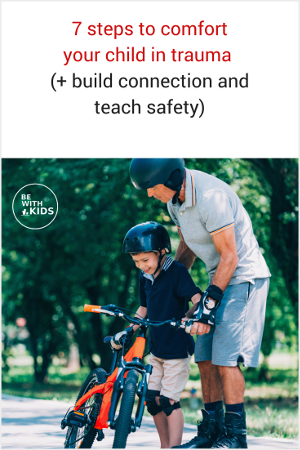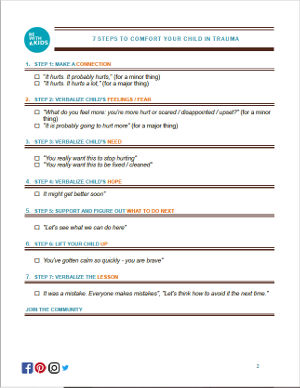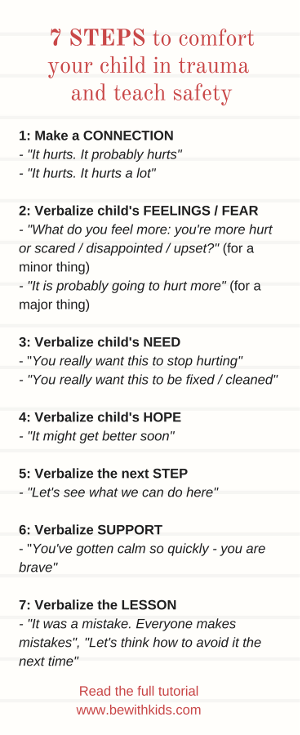How to discuss 3 of the scariest things with kids: death, traumas, and disabilities while teaching safety
- "Mommy, why did the ambulance come?" the innocent eyes ask.
Do you have a simple answer?
At some time, our kids face reality - things happen to people they love.
As parents, we are responsible for making this realization as painless as possible.
Whenever you feel your child is ready to take a new step in learning about the things that might scare him, take it gently.
It's better to discuss those topics when life is calm, and nothing happened than trying to recollect yourself dealing with some emergency and explaining it to your child at the same time.
How to discuss death while teaching kids safety
This is the scariest topic of safety. If you’ve had this conversation already, you can refer to it.
Long story short, build your conversation around three things:
- Humans are intended to live a long, happy life.
- Safety is the science of keeping yourself alive and healthy as long as you possibly can.
- If people do not follow safety rules, their life might end sooner, or they can lose their health.
Use as much generalization as you can.
Say that your kids are learning safety and are going to live a long and happy life.
This is how we were created and how our lives are intended to be.
How to discuss traumas while teaching safety

Kids do not realize the consequences of a fracture until they get one.
The only way to teach about traumas is to utilize the mishaps you get along the way.
A child got a burn? A couple of days later, get back to that situation and say:
"Remember how painful that little burn with the fingertip was?
Can you imagine how painful it would be if you put your whole hand on it rather than just your fingertip?”
Explain that our body will stay with us for all our life. It does have the capabilities to heal but not to regenerate. You can show the starfish growing their arms or lizards growing their tails. Explain that humans cannot do the same.

How to respond if your child got hurt - to build connection and teach safety
We all saw moms leaving play dates carrying their almost 8 year-olds dramatically suffering after losing a fight with a sibling.
And we also saw kiddos "I'm-okay-just-trapped-over-with-my-bike-landing-on-top" who just shook off the dirt and left you in the dust staring at their tailgates, wondering if those kids are made of rubber.
The way you respond to your children’s traumas will give them the scenario of how they are supposed to behave.
If you go into "panic mode" whenever your kids fall, kids lose the "anchor" to hold on to.
In their minds, you are the rock they can rely on if something happened, and now it is failing them.
On the other hand, just trying to stay calm and casually ask, "Are you okay?" might amplify your child's negative emotions and trigger "acting" about how badly they were hurt.
It might signal that his needs for your support were not met.
How parents accidentally open their kids to bullying
On the opposite side of the scale, if you exaggerate your response and pay too much attention to minor things, your child may subconsciously learn that to get someone's attention, he needs to get hurt.
This may lead to unhealthy patterns in their future relationships like "victim-rescuer-prosecutor" (also known as a drama triangle).
If you step in into a kid's conflict on someone's side, kids may learn that to have someone on their side (a parent, a teacher), they need to provoke that child to hurt them.
This is one reason some kids get bullied all the time and adults can't help them - because everybody knows this child is intentionally victimizing himself to manipulate the adults.
The algorithm of handling a boo-boo situation
Instead of saying "Are you okay?" or commenting on the acting, try the following algorithm (inspired by a conversation of Milton Erickson with his son) responding to the boo-boo situation.
It works with emotional trauma as well.
Step 1: Make a connection
When you see your child already hurt, come to him and say, "It hurts. It hurts a lot" (for a major thing) or "It hurts. It probably hurts" (for a minor thing).
- It will build an immediate connection between you and your child.
- And instead of your child thinking - "It's good to say are you okay - that's not you who is hurting", he feels you understand what is going on.
- Now you have his ears and trust. And a chance to say the next thing.
Otherwise, you are talking to an alien who does not hear you.
When someone is hurt, he falls into the internal part of his mind - focusing more on the inside than outside.
All the brain resources are busy figuring out the trauma. This is why people do not respond during the first couple of seconds when they are in shock.
Step 2: Verbalize child's feelings/fear
Chose Plan A or B depending on how bad the situation is.
Plan A. If the trauma is easy (he was running and fell), ask, "What do you feel more: you're more hurt or scared / disappointed / upset".
In many cases, they will say "upset / scared" and be done.
- You verbalized his FEELINGS, and you contained them.
- You addressed his needs.
- Case closed. He can run again.
The rest of the algorithm is for the bigger traumas.
Plan B. If the trauma is severe and you both understand it, say, "It is probably going to hurt more" .
- Your child has the fear that this moment is not the end, that the ER treatment and the recovery process will hurt as well.
- Your goal is to verbalize his FEAR.
- It is easier for him to hear it from you than to suspect it.
For a child, it also means you are still with him. You accept him and his feelings regardless of what has happened.
This way, you reassure him that his feelings and fears are normal.
- You are still the grown-up.
- You are accountable.
- You can handle it.
Step 3: Verbalize child's need
The next step is to say, "You want this to stop hurting" .
- This way, you verbalize his NEED.
- This is a turning point from the past to the future.
- This way, you remind your child that there is a way out. Kids usually stop crying at this point.
In some cases, if a child also ruined her dress, broke her toy, and feels upset, you can say, "You want this to be fixed / cleaned".
Step 4: Verbalize child's hope
The next step is to say, "It might get better soon" .
- This way, you verbalize his HOPE. The word "might" is important because otherwise, your child may think you are lying to him to calm him down. "Might" is giving him a way to accept hope.
Step 5: Support and figure out what to do next
The next step is to say: "Let's see what we can do here".
- Whatever you say next needs to be positive and encouraging. "You've gotten calm so quickly - you are brave."
- "Thank you for cooperating and being patient" - whatever positive you can say to support your child.
- Then examine the trauma and figure out what to do next.
Step 6: Lift your child up
When someone is hurt, his physical barrier with the world is broken.
And the emotional one is broken too.
- Feeling miserable is normal.
- Our goal is to lift the child's spirit and do not let him feel guilty.
- Offenders often try to make people feel guilty for being hurt - don't let your child fall into this - help him be resilient.
Step 7: Verbalize the lesson
At some point, it is necessary to say, "It was a mistake. Everyone makes mistakes", "Let's think how to avoid it the next time."
If you and your child learn these steps, you both will feel less panic even when the traumas are severe.
Download the checklist for the future reference
"7 STEPS to comfort your child in trauma"
↓↓↓↓↓↓

+ Receive a free mini-course on how to teach kids safety with people in a positive way

And one more thing:
Please never laugh, even if the situation looks funny (like when a child has gotten stuck in the mud and fell on his butt), and you can't help smiling.
This may hurt more than their accident.
How to discuss disabilities while teaching kids safety
The next way to start a conversation about safety mistakes that can lead to severe traumas or disabilities is to point out people in wheelchairs, people that are blind, and amenities for people that are disabled.
You need to be gentle and super delicate - you don't want to offend these people by staring, pointing, or discussing their differences with your child in front of them.
The best way is to quietly pay your child's attention to such a person and discuss it later.
- Discuss how good it is to have all your body parts functioning well.
- As well as have the complete set of all those body parts.
- That's a suitable place to start the conversation about what people can do despite their disabilities, too.
How to respond when kids ask what happened to that person:
1. You can say that it might be the way they came to this world.
2. It might also be an accident they could not control. Make sure not to scare kids when introducing the topic of misfortune.
It's tough, but it’s better kids learn it from you:
"Life may turn unfair, not the way it’s meant to be. Even though we cannot understand why and never accept it.”
Otherwise, the shock of facing something unfair happening to someone accidentally might be amplified by the child's unpreparedness: "HOW could that happen? It's so unfair!"
To make the landing softer, you can say that things like that, fortunately, do not happen very often.
3. This person with a disability might have made a huge mistake.
- ! The balance between creating the fear of mistakes and understanding is fragile.
- It will depend on how you explain that one mistake at one moment can change someone's life drastically forever.
- And that kids need to take care of their bodies and keep themselves safe.
! Warning: you don't want to place fear of making mistakes when discussing the traumas.
Even though making a mistake can put someone in a wheelchair, we are here to learn safety measures to prevent these things.
Explain that mistakes in learning are normal and beneficial, and they do not lead to a wheelchair, granted you follow the safety instructions.
But careless mistakes and neglected safety measures are dangerous.
The goal is to explain to kids:
"You are keeping yourself safe not only for the sake of your mom's sanity but because you will not be given any other body than this one".
And kids need to do everything possible never to need any help from the ambulance.
Their "tail" will not regrow.
Do you want your child to be safe with people?
Do you want a road map to safety?
Do you want your child to be safe when you are not around?
In situations you have never discussed?
Enroll in a Free online course for parents of kids 3-10 years old
"Teach Your Child Safety With Strangers (and other people)"
↓↓↓↓↓↓

Do you want:
- Your child to be safe with strangers and other people around him?
- Learn safety skills positively and practically?
- Be prepared and worry you less?
Join this free class and go from fear to confidence.
When your child breaks a safety rule he didn’t know, it may be too late to teach the rule.
Don't wait until it's too late. Our kids are the most precious of what we have - protect them.
↑↑↑↑↑↑↑
Take action
Great job so far - safety is a challenging subject!
Please sign up above to see the next steps.
↑↑↑↑↑↑↑
Can't find what you are looking for?
Please tell me what you are looking for and how I can help.
I'll be in touch.
Or try using the 

